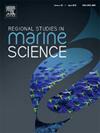Allometric aboveground biomass equations to quantify carbon content of Southeast Australian saltmarsh vegetation
IF 2.1
4区 环境科学与生态学
Q3 ECOLOGY
引用次数: 0
Abstract
Global salt marshes are significant carbon reserves, and with the growth in “blue carbon” projects, reliable quantification of its carbon storage is required. While methods for the quantification of carbon content in soils are well established, we often lack models for estimating carbon bound within plant biomass due to the high variability of growth forms among plant species. The present study aimed to develop species-specific allometric equations and carbon conversion factors that will enable the estimation of carbon stocks in above-ground biomass (AGB) of two dominant Australian saltmarsh shrubs. The linear regression models developed used lab-derived biomass and field-derived measurements of canopy diameter and/or shrub height to predict carbon content, allowing us to explain 89.3 % of observed variance in AGB for Tecticornia arbuscula and 61.5 % of observed variance in Suaeda australis. Microelemental analysis of woody tissues revealed a mean carbon content of approximately 46–48 % across both shrub species and all size classes. The species-specific AGB equations and carbon conversion factors presented here provide land managers, scientists and policymakers with non-destructive methods for rapid quantification of vegetative biomass and carbon stocks in Southeast Australian saltmarshes.
求助全文
约1分钟内获得全文
求助全文
来源期刊

Regional Studies in Marine Science
Agricultural and Biological Sciences-Ecology, Evolution, Behavior and Systematics
CiteScore
3.90
自引率
4.80%
发文量
336
审稿时长
69 days
期刊介绍:
REGIONAL STUDIES IN MARINE SCIENCE will publish scientifically sound papers on regional aspects of maritime and marine resources in estuaries, coastal zones, continental shelf, the seas and oceans.
 求助内容:
求助内容: 应助结果提醒方式:
应助结果提醒方式:


